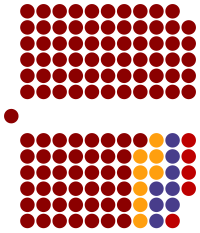Constituent Assembly of Georgia
Constituent Assembly of Georgia საქართველოს დამფუძნებელი კრება sak’art’velos damp’udznebeli kreba | |
|---|---|
| Recognized as the First Convocation of the Supreme Soviet of the Georgian SSR | |
| Leadership | |
President Of Constituent Assembly of Georgia | |
Vice-Presidents of Constituent Assembly of Georgia | Simon Mdivani |
| Structure | |
| Seats | 130 |
 | |
Political groups | Government (109) Opposition (21)
|
| Meeting place | |
The Constituent Assembly of Georgia (
Election
After the
The Constituent Assembly was elected in the free and direct elections held from 14 to 17 February 1919, to ratify the Act of Independence and adopt the republic’s constitution. The elections were contested by 15 political parties and the results were a triumph for the
The election saw fifteen women candidates stand for election, five of whom were elected to the 130 person assembly, all on the Social democratic ticket. The five elected assemblywomen were
On 21 March 1919 the Assembly elected Noe Zhordania head of government, and he formed a new cabinet.[4]
Legislation
During its two-year history, the Assembly adopted 126 laws, notably on citizenship, local elections, the country's defense, agriculture, legal system, political and administrative arrangements for ethnic minorities, a national system of public education, and some other laws and regulations on fiscal/monetary policy, the Georgian railways, trade and domestic production, etc.[5] In July 1919, the Assembly set up a Senate whose members were to be elected by the nation’s legislative body to "supervise the observance and defense of laws and to ensure strict adherence to them by all organizations, persons, and local government organs." The Senate was essentially an appellate court but also had the power to revoke any government decision contrary to law and to deal with complaints against courts.[6]
Preoccupied with uneasy foreign relations and domestic problems in the years of the
References
- ISBN 0-19-924958-X.
- ^ Ugrekhelidze, Mariam (2018). "The five women who crafted the Georgian constitution". JAMnews. Retrieved 8 February 2020.
- ^ "Exhibition honours women of Georgia's first Constituent Assembly in 1919-1921". Agenda.ge. Retrieved 2022-12-14.
- ^ (in Georgian) The Constituent Assembly, 1919-21. Parliament of Georgia.
- ^ David Losaberidze (1998), The Problem of Nationalism in Georgia, pp. 5-6. The NATO Research Fellowships Program.
- ^ ISBN 90-04-13947-8.
External links
- (in Georgian) Collection of legal acts adopted by the Constituent Assembly of Georgia, 1919-21. Regional Research Center.
